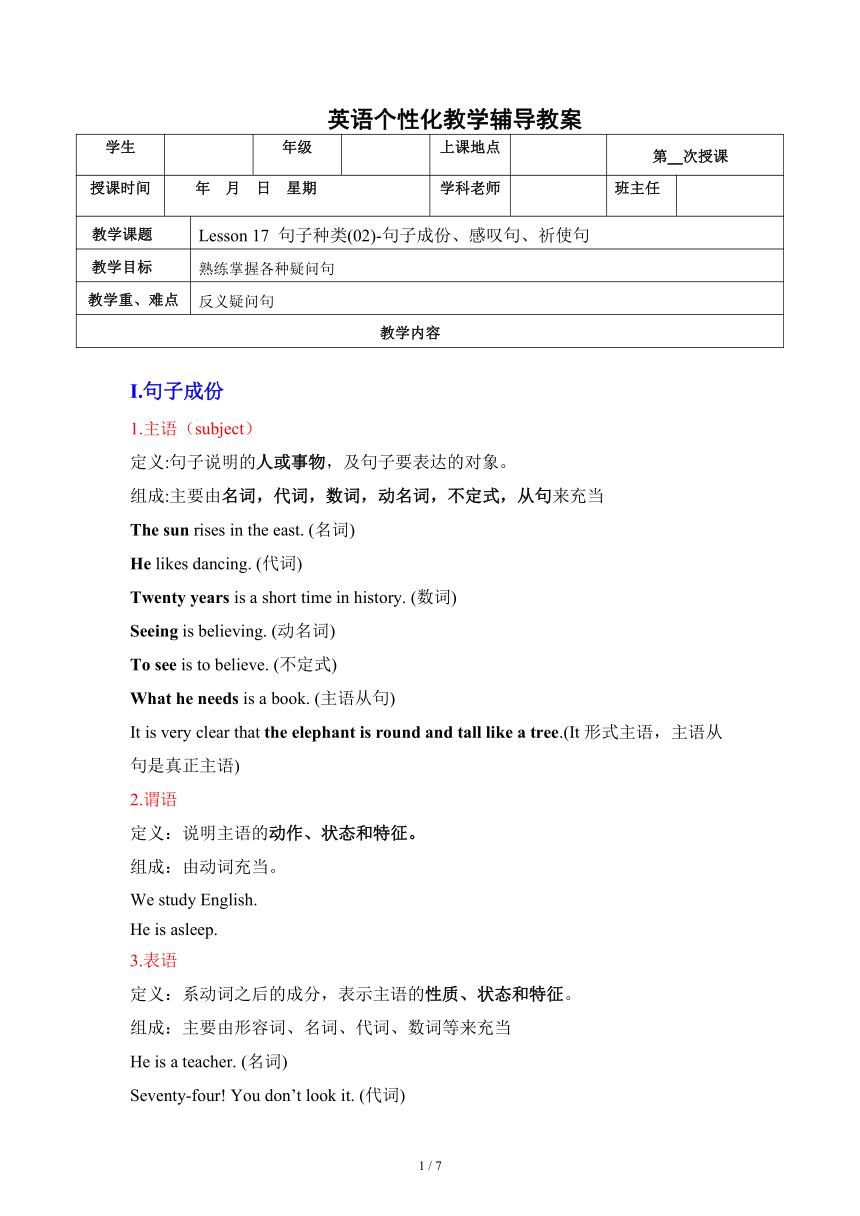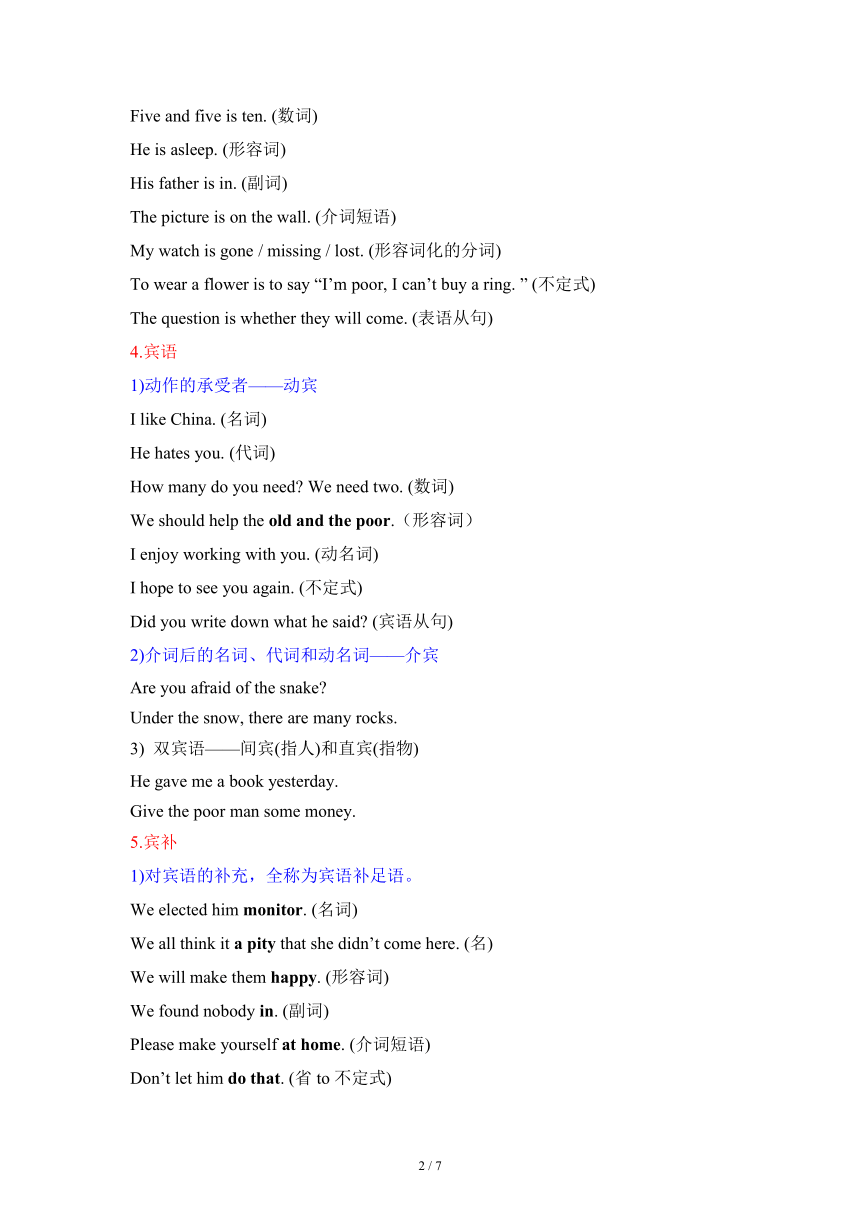2022年中考英语语法专题-第17讲句子种类(2).句子成份、祈使句、感叹句、倒装句教案(word版)
文档属性
| 名称 | 2022年中考英语语法专题-第17讲句子种类(2).句子成份、祈使句、感叹句、倒装句教案(word版) |  | |
| 格式 | docx | ||
| 文件大小 | 31.4KB | ||
| 资源类型 | 教案 | ||
| 版本资源 | 通用版 | ||
| 科目 | 英语 | ||
| 更新时间 | 2022-01-19 08:51:30 | ||
图片预览



文档简介
英语个性化教学辅导教案
学生 年级 上课地点 第 次授课
授课时间 年 月 日 星期 学科老师 班主任
教学课题 Lesson 17 句子种类(02)-句子成份、感叹句、祈使句
教学目标 熟练掌握各种疑问句
教学重、难点 反义疑问句
教学内容
I.句子成份
1.主语(subject)
定义:句子说明的人或事物,及句子要表达的对象。
组成:主要由名词,代词,数词,动名词,不定式,从句来充当
The sun rises in the east. (名词)
He likes dancing. (代词)
Twenty years is a short time in history. (数词)
Seeing is believing. (动名词)
To see is to believe. (不定式)
What he needs is a book. (主语从句)
It is very clear that the elephant is round and tall like a tree.(It形式主语,主语从句是真正主语)
2.谓语
定义:说明主语的动作、状态和特征。
组成:由动词充当。
We study English.
He is asleep.
3.表语
定义:系动词之后的成分,表示主语的性质、状态和特征。
组成:主要由形容词、名词、代词、数词等来充当
He is a teacher. (名词)
Seventy-four! You don’t look it. (代词)
Five and five is ten. (数词)
He is asleep. (形容词)
His father is in. (副词)
The picture is on the wall. (介词短语)
My watch is gone / missing / lost. (形容词化的分词)
To wear a flower is to say “I’m poor, I can’t buy a ring. ” (不定式)
The question is whether they will come. (表语从句)
4.宾语
1)动作的承受者——动宾
I like China. (名词)
He hates you. (代词)
How many do you need We need two. (数词)
We should help the old and the poor.(形容词)
I enjoy working with you. (动名词)
I hope to see you again. (不定式)
Did you write down what he said (宾语从句)
2)介词后的名词、代词和动名词——介宾
Are you afraid of the snake
Under the snow, there are many rocks.
3) 双宾语——间宾(指人)和直宾(指物)
He gave me a book yesterday.
Give the poor man some money.
5.宾补
1)对宾语的补充,全称为宾语补足语。
We elected him monitor. (名词)
We all think it a pity that she didn’t come here. (名)
We will make them happy. (形容词)
We found nobody in. (副词)
Please make yourself at home. (介词短语)
Don’t let him do that. (省to不定式)
His father advised him to teach the lazy boy a lesson. (带to不定式)
Don’t keep the lights burning. (现在分词)
I’ll have my bike repaired. (过去分词)
2)主补:对主语的补充。
He was elected monitor.
She was found singing in the next room.
He was advised to teach the lazy boy a lesson.
6.定语
修饰或限制名词或代词的词、词组或句子。
Ai Yanling is a chemistry teacher.(名词)
He is our friend. (代词)
We belong to the third world. (数词)
He was advised to teach the lazy boy a lesson.(形容词)
The man over there is my old friend.(副词)
The woman with a baby in her arms is my sister. (介词)
The boys playing football are in Cla2. (现在分词)
The trees planted last year are growing well now. (过去分词)
I have an idea to do it well. (不定式)
You should do everything that I do. (定语从句)
7.状语
用来修饰v.,对句子动作发生背景予以说明。
可以由 adj., adv., 或者句子。
表示时间、地点、原因、目的、结果、程度、条件、方式和让步。
(以下例句按上述顺序排列)
I will go there tomorrow.
The meeting will be held in the meeting room.
The meat went bad because of the hot weather.
He studies hard to learn English well.
He didn’t study hard so that he failed in the exam.
I like some of you very much.
If you study hard, you will pass the exam.
He goes to school by bike.
Though he is young, he can do it well.
II.句子种类
按其结构可以分为以下三类:
1)简单句(Simple Sentences):只包含一个主谓结构句子叫简单句
She is fond of collecting stamps.
(主) (谓)
2)并列句(Compound Sentences):包含两个或两个以上主谓结构的句子叫并列句,句与句之间通常用并列连词或分号来连接,如:
The food was good, but he had little appetite.
(主) (谓) (主)(谓)
3)复合句(Complex Sentences):包含一个主句和一个或几个从句的句子叫复合句,从句由从属连词引导.
The film had begun when we got to the cinema.
主句 从句
III.基本句型
英语中千变万化的句子归根结底都是由以下五种基本句型组合、扩展、变化而来的:
1)主 + 动(SV)
I work. 我工作。
2)主 + 动 + 表(SVP)
John is busy. 约翰忙。
3)主 + 动 + 宾(SVO)
She studies English. 她学英语。
4)主 + 动 + 宾 + 补(SVOC)
Time would prove me right. 时间会证明我是对的。
5)主 + 动 + 间宾 + 直宾(SVOiOd)
My mother made me a new dress. 我母亲给我做了一件新衣裳
IV.感叹句
(1)what 型感叹句:what 修饰名词
①what +a / an +形容词+可数名词单数+(主语+谓语)!
What a wonderful time we had yesterday!
②what+形容词+可数名词复数(主语+谓语)
What beautiful flowers (they are)!
③what+形容词+不可数名词(主语+谓语)
What fine weather (it is)!
(2)how 型感叹句: how 修饰形容词、 副词、动词
①How +形容词、副词(主语+谓语)
How clover she is!
②how+形容词+a/ an +可数名词单数(主语)+谓语动词
How wonderful an idea is.
③how+主语+谓语
How he worked! / How I miss you!
V.祈使句
1.祈使句的句式特征
祈使句用来表示说话人的请求、命令、建议、劝告。祈使句的主语一般为第二人称(通常省略),有时也可用everybody, somebody, anybody 等不定代词
(You) put on more clothes. It’s cold outside.
Someone answer the phone.
2.祈使句的形式
(1)祈使句的肯定形式
祈使句的肯定句式一般分为以下三种类型:
①Do型:动词原形(+宾语)+其他
Come in, please!
有的祈使句在意思明确的情况下可省略动词。
This way please!= Go this way, please!
②Be 型:be +表语(名词、形容词)+其他
Be a good boy.
③let 型:Let +宾语+动词原形+其他
Let me have a look.
Let us play basketball.
(2)祈使句的否定形式
do 型祈使句和be型祈使句的否定式为:Don’t / Never +祈使句
Never do it like that.
Don’t be late for school.
let 型祈使句有两种情况:
a. Let +宾语(第一人称)+not +动词原形+其他
Let’s not waste the time.
b. Don’t +let +宾语(第三人称)+动词原形+其他
Don’t let him go there.
c. No + doing/ n 禁止做某事
No smoking.
⑶祈使句的强调形式:Do + 动词原形+其他|
Do tell her about that.
Do be careful next time.
3.祈使句表示假设的情况
⑴“祈使句+and+陈述句(用一般将来时)”。它的两种特殊形式:
名词词组+and+陈述句, 名词词组通常含有more, another, further, earlier等词。
One step further and you will fall down.
Just a little patience and we will look into it soon.
“祈使句+破折号+陈述句”
Try some of this juice---perhaps you’ll like it.
⑵“祈使句+or/otherwise+陈述句”,相当于“If …not +主句”
Hurry up or we will be late for the meeting.=If we don’t hurry up, we will be late for the meeting.
4.祈使句的反意问句
祈使句的反意疑问句须按其句子结构及讲话人的语气来决定其疑问部分。通常有以下三种形式:
⑴祈使句为肯定句式,其反意疑问句表示请求时,通常用will you;表示邀请、劝说时,用won’t you。
Be sure to write to us, will you 你一定要给我们写信,好吗
Come to have dinner with us this evening, won’t you 今晚来和我们一起吃饭,好吗?
⑵祈使句为否定句式,其反意疑问句通常只用will you。
Don’t smoke in the meeting room, will you 不要在会议室抽烟,好吗?
⑶Let开头的祈使句构成反意疑问句时,除Let’s用shall we外,其他均用will you。
Let the boy go first, will you 让个那男孩先走,好吗?
Let’s take a walk after supper, shall we 晚饭后我们去散步,好吗?
5.祈使句的回答
祈使句的动作通常是表示将来发生的动作,所以回答祈使句时,一般用will或won’t。
在回答具有否定意义的祈使句时,要注意两点:
一是“形式一致”,即Yes与will保持一致;No与won’t保持一致。
二是“意思相反”,即Yes是“不”的意思;No是“是”的意思。
Don’t go out, please. It’s raining heavily outside.请不要出去。外面雨下得很大。
Yes, I will. I have to meet my brother at the airport.不行,我得去机场接我弟弟。
IV.倒装句
so +助动词、情态动词、be动词+另一主语,意思为:“…也是如此”
neither/ nor+助动词、情态动词、be动词+另一主语,意思为:“…也不如此”
Tom can speak Chinese. So can Mary.
Mr Li had gone to America. So had Mrs Li.
注意:
不要和so +同一主语+助动词、情态动词、be 动词弄混。
He likes playing basketball.
So he does.
学生 年级 上课地点 第 次授课
授课时间 年 月 日 星期 学科老师 班主任
教学课题 Lesson 17 句子种类(02)-句子成份、感叹句、祈使句
教学目标 熟练掌握各种疑问句
教学重、难点 反义疑问句
教学内容
I.句子成份
1.主语(subject)
定义:句子说明的人或事物,及句子要表达的对象。
组成:主要由名词,代词,数词,动名词,不定式,从句来充当
The sun rises in the east. (名词)
He likes dancing. (代词)
Twenty years is a short time in history. (数词)
Seeing is believing. (动名词)
To see is to believe. (不定式)
What he needs is a book. (主语从句)
It is very clear that the elephant is round and tall like a tree.(It形式主语,主语从句是真正主语)
2.谓语
定义:说明主语的动作、状态和特征。
组成:由动词充当。
We study English.
He is asleep.
3.表语
定义:系动词之后的成分,表示主语的性质、状态和特征。
组成:主要由形容词、名词、代词、数词等来充当
He is a teacher. (名词)
Seventy-four! You don’t look it. (代词)
Five and five is ten. (数词)
He is asleep. (形容词)
His father is in. (副词)
The picture is on the wall. (介词短语)
My watch is gone / missing / lost. (形容词化的分词)
To wear a flower is to say “I’m poor, I can’t buy a ring. ” (不定式)
The question is whether they will come. (表语从句)
4.宾语
1)动作的承受者——动宾
I like China. (名词)
He hates you. (代词)
How many do you need We need two. (数词)
We should help the old and the poor.(形容词)
I enjoy working with you. (动名词)
I hope to see you again. (不定式)
Did you write down what he said (宾语从句)
2)介词后的名词、代词和动名词——介宾
Are you afraid of the snake
Under the snow, there are many rocks.
3) 双宾语——间宾(指人)和直宾(指物)
He gave me a book yesterday.
Give the poor man some money.
5.宾补
1)对宾语的补充,全称为宾语补足语。
We elected him monitor. (名词)
We all think it a pity that she didn’t come here. (名)
We will make them happy. (形容词)
We found nobody in. (副词)
Please make yourself at home. (介词短语)
Don’t let him do that. (省to不定式)
His father advised him to teach the lazy boy a lesson. (带to不定式)
Don’t keep the lights burning. (现在分词)
I’ll have my bike repaired. (过去分词)
2)主补:对主语的补充。
He was elected monitor.
She was found singing in the next room.
He was advised to teach the lazy boy a lesson.
6.定语
修饰或限制名词或代词的词、词组或句子。
Ai Yanling is a chemistry teacher.(名词)
He is our friend. (代词)
We belong to the third world. (数词)
He was advised to teach the lazy boy a lesson.(形容词)
The man over there is my old friend.(副词)
The woman with a baby in her arms is my sister. (介词)
The boys playing football are in Cla2. (现在分词)
The trees planted last year are growing well now. (过去分词)
I have an idea to do it well. (不定式)
You should do everything that I do. (定语从句)
7.状语
用来修饰v.,对句子动作发生背景予以说明。
可以由 adj., adv., 或者句子。
表示时间、地点、原因、目的、结果、程度、条件、方式和让步。
(以下例句按上述顺序排列)
I will go there tomorrow.
The meeting will be held in the meeting room.
The meat went bad because of the hot weather.
He studies hard to learn English well.
He didn’t study hard so that he failed in the exam.
I like some of you very much.
If you study hard, you will pass the exam.
He goes to school by bike.
Though he is young, he can do it well.
II.句子种类
按其结构可以分为以下三类:
1)简单句(Simple Sentences):只包含一个主谓结构句子叫简单句
She is fond of collecting stamps.
(主) (谓)
2)并列句(Compound Sentences):包含两个或两个以上主谓结构的句子叫并列句,句与句之间通常用并列连词或分号来连接,如:
The food was good, but he had little appetite.
(主) (谓) (主)(谓)
3)复合句(Complex Sentences):包含一个主句和一个或几个从句的句子叫复合句,从句由从属连词引导.
The film had begun when we got to the cinema.
主句 从句
III.基本句型
英语中千变万化的句子归根结底都是由以下五种基本句型组合、扩展、变化而来的:
1)主 + 动(SV)
I work. 我工作。
2)主 + 动 + 表(SVP)
John is busy. 约翰忙。
3)主 + 动 + 宾(SVO)
She studies English. 她学英语。
4)主 + 动 + 宾 + 补(SVOC)
Time would prove me right. 时间会证明我是对的。
5)主 + 动 + 间宾 + 直宾(SVOiOd)
My mother made me a new dress. 我母亲给我做了一件新衣裳
IV.感叹句
(1)what 型感叹句:what 修饰名词
①what +a / an +形容词+可数名词单数+(主语+谓语)!
What a wonderful time we had yesterday!
②what+形容词+可数名词复数(主语+谓语)
What beautiful flowers (they are)!
③what+形容词+不可数名词(主语+谓语)
What fine weather (it is)!
(2)how 型感叹句: how 修饰形容词、 副词、动词
①How +形容词、副词(主语+谓语)
How clover she is!
②how+形容词+a/ an +可数名词单数(主语)+谓语动词
How wonderful an idea is.
③how+主语+谓语
How he worked! / How I miss you!
V.祈使句
1.祈使句的句式特征
祈使句用来表示说话人的请求、命令、建议、劝告。祈使句的主语一般为第二人称(通常省略),有时也可用everybody, somebody, anybody 等不定代词
(You) put on more clothes. It’s cold outside.
Someone answer the phone.
2.祈使句的形式
(1)祈使句的肯定形式
祈使句的肯定句式一般分为以下三种类型:
①Do型:动词原形(+宾语)+其他
Come in, please!
有的祈使句在意思明确的情况下可省略动词。
This way please!= Go this way, please!
②Be 型:be +表语(名词、形容词)+其他
Be a good boy.
③let 型:Let +宾语+动词原形+其他
Let me have a look.
Let us play basketball.
(2)祈使句的否定形式
do 型祈使句和be型祈使句的否定式为:Don’t / Never +祈使句
Never do it like that.
Don’t be late for school.
let 型祈使句有两种情况:
a. Let +宾语(第一人称)+not +动词原形+其他
Let’s not waste the time.
b. Don’t +let +宾语(第三人称)+动词原形+其他
Don’t let him go there.
c. No + doing/ n 禁止做某事
No smoking.
⑶祈使句的强调形式:Do + 动词原形+其他|
Do tell her about that.
Do be careful next time.
3.祈使句表示假设的情况
⑴“祈使句+and+陈述句(用一般将来时)”。它的两种特殊形式:
名词词组+and+陈述句, 名词词组通常含有more, another, further, earlier等词。
One step further and you will fall down.
Just a little patience and we will look into it soon.
“祈使句+破折号+陈述句”
Try some of this juice---perhaps you’ll like it.
⑵“祈使句+or/otherwise+陈述句”,相当于“If …not +主句”
Hurry up or we will be late for the meeting.=If we don’t hurry up, we will be late for the meeting.
4.祈使句的反意问句
祈使句的反意疑问句须按其句子结构及讲话人的语气来决定其疑问部分。通常有以下三种形式:
⑴祈使句为肯定句式,其反意疑问句表示请求时,通常用will you;表示邀请、劝说时,用won’t you。
Be sure to write to us, will you 你一定要给我们写信,好吗
Come to have dinner with us this evening, won’t you 今晚来和我们一起吃饭,好吗?
⑵祈使句为否定句式,其反意疑问句通常只用will you。
Don’t smoke in the meeting room, will you 不要在会议室抽烟,好吗?
⑶Let开头的祈使句构成反意疑问句时,除Let’s用shall we外,其他均用will you。
Let the boy go first, will you 让个那男孩先走,好吗?
Let’s take a walk after supper, shall we 晚饭后我们去散步,好吗?
5.祈使句的回答
祈使句的动作通常是表示将来发生的动作,所以回答祈使句时,一般用will或won’t。
在回答具有否定意义的祈使句时,要注意两点:
一是“形式一致”,即Yes与will保持一致;No与won’t保持一致。
二是“意思相反”,即Yes是“不”的意思;No是“是”的意思。
Don’t go out, please. It’s raining heavily outside.请不要出去。外面雨下得很大。
Yes, I will. I have to meet my brother at the airport.不行,我得去机场接我弟弟。
IV.倒装句
so +助动词、情态动词、be动词+另一主语,意思为:“…也是如此”
neither/ nor+助动词、情态动词、be动词+另一主语,意思为:“…也不如此”
Tom can speak Chinese. So can Mary.
Mr Li had gone to America. So had Mrs Li.
注意:
不要和so +同一主语+助动词、情态动词、be 动词弄混。
He likes playing basketball.
So he does.
